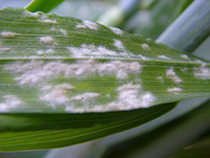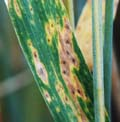Following infection, the fungus develops for some time in the plant before symptoms appear. Latent period varies between the different diseases from 4-5 days to 3 weeks. Symptoms on lower leaves are generally less important compared with symptoms appearing on yield-forming upper leaves. Most control strategies aim at keeping the 3 upper leaves free from diseases.
Disease development is very complex and the severity of diseases in a season depends on the amount of disease inoculum, weather and the variety's genetic ability to 'resist' that pressure. A higher fungicide dose is needed when disease pressure is high and varietal resistance is low. Conversely, a resistant variety facing low disease pressure may not require any treatment.
Unfortunately disease forecasting is not a very precise discipline. Therefore risk assessment is often reduced to estimating, if risk of disease development is nil, low, moderate or high. Threshold is however still believed to be of good value, when the risk has to be decided.





